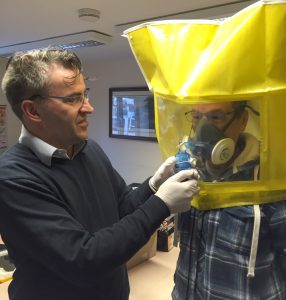 Protecting your workforce from airborne hazard
Protecting your workforce from airborne hazard
Where RPE is used, it must be able to provide adequate protection for individual wearers. RPE can’t protect the wearer if it leaks.
A major cause of leaks is poor fit – tight-fitting facepieces need to fit the wearer’s face to be effective.
A qualitative fit test is a pass/fail test that relies on the employee’s response to a test agent. The OSHA protocols include saccharin, isoamyl acetate (banana oil), Bitrex and irritant smoke.
For a saccharin or Bitrex test, an administrator challenges a subject wearing a respirator with a test aerosol. The subject dons the respirator and a fit test hood. The test aerosol is sprayed inside the hood while the subject performs prescribed exercises. If the subject can taste the test agent, the respirator fails the test and another respirator must be tested.
The fit test procedure requires about 15 to 20 minutes per person.
As people come in all sorts of shapes and sizes it is unlikely that one particular type or size of RPE facepiece will fit everyone. Fit testing will ensure that the equipment selected is suitable for the wearer.
The best time to do fit testing is at the initial selection stage, when individual users can be given a choice of adequate models of RPE. You should ensure that the make, model, type and size of facepiece that they wore when they had their successful fit test is made available for their use. If an employee wears more than one type of tight-fitting facepiece, then each type of facepiece should be fit tested.
